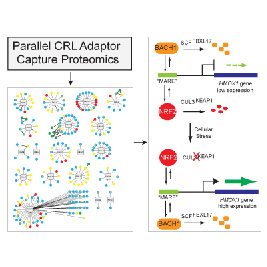 Modular Cullin-RING E3 ubiquitin ligases (CRLs) use substrate binding adaptor proteins to specify target ubiquitylation. Many of the ~200 human CRL adaptor proteins remain poorly studied due to a shortage of efficient methods to identify biologically relevant substrates. As reported in Molecular Cell, the Harper Lab has developed Parallel Adaptor Capture (PAC) proteomics as a new approach for the identification of CRL substrates. They used the method to systematically identify candidate targets for the leucine-rich repeat family of F-box proteins (FBXLs) that function with SKP1-CUL1-F-box protein (SCF) E3s. This led to the identification of dozens on candidate substrates across the FBXL family. In validation experiments, they identified the unstudied F-box protein FBXL17 as a regulator of the NFR2 oxidative stress pathway, and demonstrated that FBXL17 controls the transcription of the NRF2 target HMOX1 via turnover of the transcriptional repressor BACH1 in the absence or presence of extrinsic oxidative stress. This work identifies a role for SCFFBXL17 in controlling the threshold for NRF2-dependent gene activation and provides a framework for elucidating the functions of CRL adaptor proteins.
Modular Cullin-RING E3 ubiquitin ligases (CRLs) use substrate binding adaptor proteins to specify target ubiquitylation. Many of the ~200 human CRL adaptor proteins remain poorly studied due to a shortage of efficient methods to identify biologically relevant substrates. As reported in Molecular Cell, the Harper Lab has developed Parallel Adaptor Capture (PAC) proteomics as a new approach for the identification of CRL substrates. They used the method to systematically identify candidate targets for the leucine-rich repeat family of F-box proteins (FBXLs) that function with SKP1-CUL1-F-box protein (SCF) E3s. This led to the identification of dozens on candidate substrates across the FBXL family. In validation experiments, they identified the unstudied F-box protein FBXL17 as a regulator of the NFR2 oxidative stress pathway, and demonstrated that FBXL17 controls the transcription of the NRF2 target HMOX1 via turnover of the transcriptional repressor BACH1 in the absence or presence of extrinsic oxidative stress. This work identifies a role for SCFFBXL17 in controlling the threshold for NRF2-dependent gene activation and provides a framework for elucidating the functions of CRL adaptor proteins.